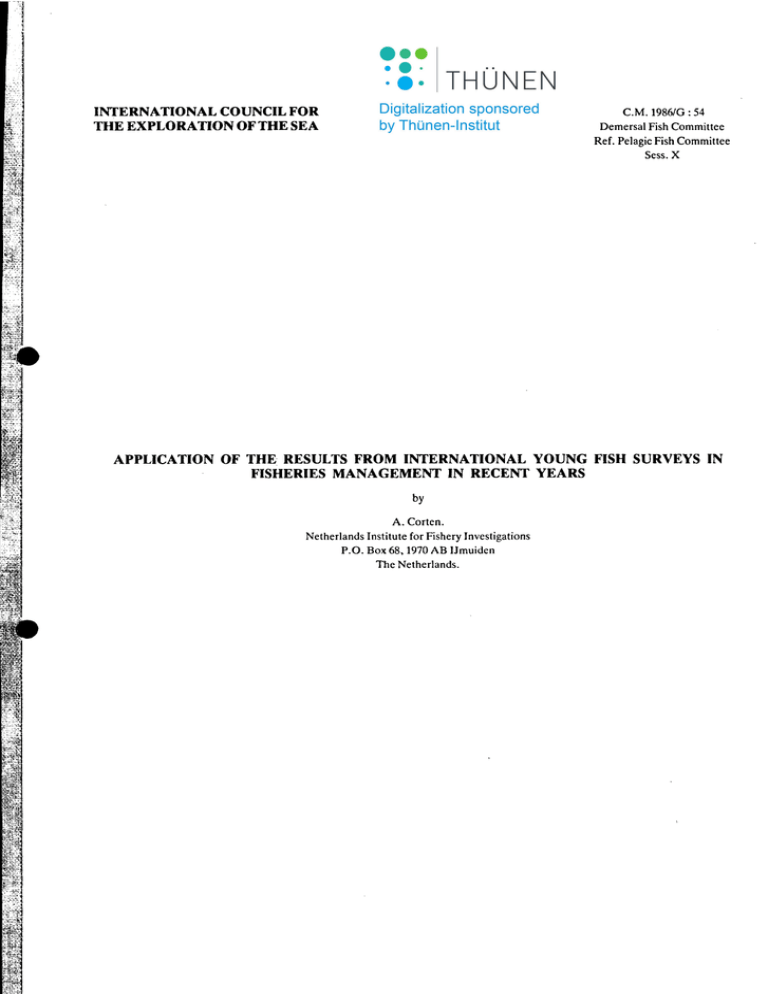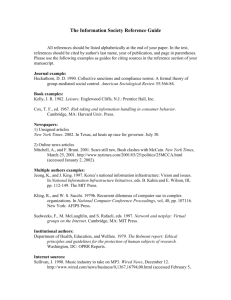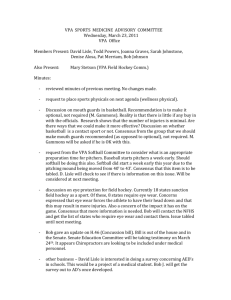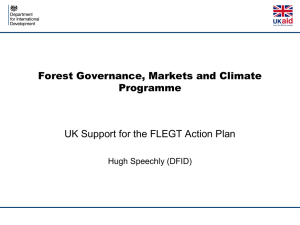INTERNATIONAL COUNCIL FOR TUE EXPLORATION OFTUE SEA
advertisement

INTERNATIONAL COUNCIL FOR TUE EXPLORATION OFTUE SEA C.M. 1986/G: 54 Demersal Fish Committee Ref. Pelagic Fish Committee Sess. X APPLICATION OF THE RESULTS FROM INTERNATIONAL YOUNG FISH SURVEYS IN FISHERIES MANAGEMENT IN RECENT YEARS by A. Corten. Netherlands Institute for Fishery Investigations P.O. Box 68,1970 AB IJmuiden The Netherlands. INTERNATIONAL COUNCIL FOR THE EXPLORATION OF THE SEA ICES C.M.1986/G:54 Demersal Fish Committee Ref. Pelagic Fish Committee Sess.X APPLICATION OF THE RESULTS FROH THE INTERNATIONAL YOUNG FISH SURVEYS IN FISHERIES MANAGEHENT IN RECENT YEARS by A. Corten Netherlands Institute for Fisheries Investigations P.O.Box 68, 1970 AB IJMUIDEN The Netherlands Abstract Recruitment estimates derived from the International Young Fish Surveys have been used extensively in recent years in setting TAC's for North Sea herring, haddock,.and whiting. For other species, IYFS abundance indices have been less useful, either because of a poor correlation between IYFS and VPA (cod), or because the fishery is mainly exploiting 1 year old fish (Norway pout, sprat) and TAC's have to be set before recruitment forecasts are available. There is still considerable room for increased application of survey results, particularly the abundance indices for 2 year old roundfish and herring. When using IYFS indices for predicting year class strength, working groups should indicate the confidence interval of the predicted value, in order to avoid a false impression of precision. 1. INTRODUCTION The International Young Fish Survey (IYFS)," conducted each February in North Sea, Skagerrak and Kattegat is presently one of the largest international research efforts coordinated by ICES. Seven laboratories in 6 different countries participate in this programme, and the total amount of ship time each year is approximately 200 days. The primary objective of the survey is to provide annual forecasts of recruitment in the various commercial fish species of the North Sea and Skagerrak/Kattegat. This paper considers the value of the survey indices as estimators of recruitment, and sometimes of total stock size, in the various fish species. As such, it is an extension of a similar review presented in the report of the Working Group on International Young Fish Surveys (Anon., 1985a). Apart from considering the use of survey results in a bit more detail, this paper also presents some personal views on the usefulness and future potential of the survey. ,I paßc 2 I I The review presented in this paper is limited main1y to the direct app1ication of survey resu1ts for management of commercia1 speeies. However, in addition to abundance indices for commereia1 species, the IYFS also produces a wea1th of information on the distribution and abundance of a 1arge number of by-eateh species. This information, whieh is present1y also being stored in the IYFS data base in Copenhagen, will be usefu1 for monitoring 10ng term ehanges in the North Sea eeosystem, and thereby indirect1y have a bearing on the management of commereial speeies. I ~ Another important use of the survey not further discussed here, is the co11ection of synoptic hydrographica1 data and of specific bio1ogica1 data such as food consumption in various species. The latter information has been used extensive1y by the ICES Mu1tispecies Assessment Working Group (Anon., 1986a), and the conc1usions of the Working Group coneerning predation morta1ity on younger age groups have been most va1uab1e in roundfish and herring assessment. • Before discussing the present use of survey results, abrief history of the survey is presented. This i1lustrates how the objeetives of a primarily bio1ogica1 survey have been amended over the years to estab1ish a programme which is now an important tool for fisheries management • Details on the methodo1ogy of the survey can be found in the Survey Manual (Anon., 1986b). 2. ABRIEF HISTORY OF TIIE IYFS • The IYFS has a 10ng history, going back to the years 1960/61, when the first large international surveys were organised under ICES auspices. These first surveys were aimed exc1usive1y at juvenile herring: the distribution of this age group was studied, and it was tried to re1ate the juvenile herring in the various nurseries to the different adult populations in the North Sea. The purpose of this exercise was to estimate what effect the deve10ping fishery for juvenile herring in the south-eastern North Sea might have on the various adult populations. A1though these surveys provided a lot of information on the distribution of juvenile herring, the final objective was-not reached because it was not possible to make an accurate split of 1-ringers into racia1 components (Burd, 1969). After a short interruption, the surveys were resumed from 1965 onwards, with the more modest objective to obtain annua1 recruitment forecasts for the combined North Sea herring stocks. In these ear1ier years, the value of recruitment forecasts for management was limited, main1y because there were no effective international agreements for herring conservation. The main value of recruitment forecasts was to help the industry anticipate next year's catch levels. Over the years, it was gradua1ly realized that the IYFS (or rather the Young Herring Survey as it was ca11ed at that time) cou1d not only provide recruitment forecasts for herring, but also for roundfish species such as cod, haddock, and whiting. A special working group was set up to investigate i r [ page 3 the usefulness of roundfish data collected during the survey (Anon., 1976). Because the results looked promising, the objectives of the survey were widened to include also the sampling of young gadoid species. This meant that the survey area had to be extended northward, to fully cover the distribution area of juvenile haddock and Norway pout. During the first years of the survey, it was recommended to use a 78 ft Dutch herring trawl as standard gear. However, this gear could not be operated from slipway trawlers, so most participants used other gears of approximately the same dimensions. This situation was not very satisfactory, and in 1976 a new standard gear was proposed: the French GOV bottom trawl (chalut a Grande Ouverture Verticale). This net was accepted by all participants in the survey, and its introduction has greatly increased the comparability of catch rates, and thereby the reliabi1ity of survey indices. Arecent analysis of inter-ship variation (Buijse and Daan, 1986) shows that hardly any significant inter-ship differences in catch rate existed in recent years. • • The great demand for survey results came with the introduction of the TAC management system in the North Sea around 1975. Suddenly, recruitment forecasts became a vital part of the biological advice for the annual TAC's in various species. ICES assessment working groups, meeting short1y after the IYFS, suddenly became very interested in obtaining recruitment forecasts immediately after the survey. As it was not possible for technical reasons to produce final indices so shortly after the end of the survey (no age-readings were yet available from all participants), it was decidedto produce preliminary estimates for the youngest age group in each species on the basis of fixed length criteria (herring < 20cm, cod < 25 cm, etc.). These results were exchanged already whi1e the ships were still at sea, and preliminary indices based'on these lengtll categories were available within a few weeks after the end of the survey. Indices for age 2 and older fish were calculated only after all age/length data had been analysedj these results were normally exchanged later in the year, so they were not avai.lable to the assessment working groups meetings shortly after the survey. In the early 1980's the decision was taken to exchange survey results on magnetic tape instead of on the traditional paper record forms. The switch to automatic da ta processing, however, turned out to be far more complicated than was expected. In the following years, many participants had great problems in providing error-free tapes, and also the development of computer programs for data analysis took much longer than was foreseen. As most participants had stoppedthe exchange of data in the traditional format in 1983, the result was that no final survey results became available from 1983 onwards. Only in 1986, a first attempt could be made to analyse computerized data from the 1983-85 surveys (Anon., 1986c). While the original attempts at collecting and analysing computerized data were made at the Dutch laboratory in IJmuiden, it was decided in 1982 to shift this task to ICES headquarters in Copenhagen, and to set up a IYFS data base at this place (Anon., 1982a). Also this attempt at computer processing of survey results was no immediate succes. Even at this stage (summer 1986), the data base is not yet fully operational, and assessment working groups in 1986 still had to work with preliminary indices, calculated directly after the survey by the participants themselves. paGe 4 One of the main causes for the delay in computer processing was the decision that the new data base should not only contain the usual age/length data for 0. seleeted number of eommereial speeies, but also a large amount of additional information on length distributions of all fish species caught. The idea was to increase the use of the survey by having access to mueh more of the material eolleeted. However, the expansion of the volume of data to be handled greatly slowed down the process of da ta exchange and analysis, with the result that the primary objeetive providing timely recruitment"forecasts on the few commercial species - has not yet been achieved. This bottleneck is presently being reviewed, and in future surveys extra provisions must be made to have abundance indices for commercial species quickly available, even if automatie data processing systems might fail again. Arecent development in herring forecasting has been the addition of a plankton sampling programme to the IYFS. This extra programme is aimed at herring larvae of 5 months old, which are sampled by means of an Isaacs-Kidd Midwater Trawl (IKMT). • 3. IYFS INDICES AS ESTHlATORS OF DIFFERENT AGE GROUPS IN NORTH SEA SPECIES The IYFS Working Group in 1985 reviewed the available da ta on the relationship between IYFS indices and VPA estimates of year class strength for the various species (Anon., 19850.). The resulting plots and regression equations are reproduced here in Figures 1-13. It has not been attempted to update these plots and regressions, as this work will be done during the next meeting of the Working Group. The results of the plots shown in Figures 1 - 15 may be summarized as foliows: lIerring (Figure 1,2) For I-ringers a good correlation exists between IYFS indices and VPA estimates. Many attempts have been made to spUt the IYFS index for this age group into racial components, in order to obtain separate recruitment forecasts for the individual North Sea populations (the southern North Sea population has been treated as a separate management unit in recent years). However, although there are small differences in meristic characters between the various populations, these differences are too variable from year to year to use them at the time of the lYFS when the pure stock characteristics of the recruiting year class are still unknown. The relationship for 2-ringers has not been investigated in recent years. It was assumed that schooling habits of older herring would lead to an increased inter-haul variance, and thereby to a larger error on the survey mean. Also, the older herring will probably be distributed in deeper water, where they have a more pelagic distribution, and are less vulnerable to a bottom trawl. Still, it would be advisable to review existing data to make sure that the 2-ringers index really cannot be used to update the first estimate based on I-ringers. page 5 The results of the IKMT programme suggest that the abundance of larvae at an age of 5 months might be used as a first indication of year class strength (Figure 2). It is not to be expected, however, that recruitment forecasts based on larval abundance will ever obtain the same precision as the estimates based on I-ringers, due to the high and variable natural mortality that the year class will experience after the time of IKMTsampling. Still, the IKHT index might be quite useful for management, as an early warning against weak year classes. eod (Figures 3,4,5) For age 1, the regression between IYFS and VPA is not significant. When a logarithmic transformation is applied to both parameters (ln(x+1)), the regression becomes significant. The value of this regression for recruitment forecasting, however, is questionab1e (see section 6). For age 2, a significant regression is obtained between IYFS and VPA. Haddock(Figures 6,7) Significant correlations between VPA and IYFS exist for both age 1 and age 2. Whiting (Figures 8,9) Significant correlations between IYFS and VPA exist for age 1 and age 2. However, the intercept on the Y-axis is high in both cases (50% of an average year class in age 1). This limits the value oE the regressions for prediction purposes. Sprat (Figure 10) VPA values of year class strength are of doubtful value because of the uncertain, but presumably very high values of natural mortality. Therefore, no attempts have been made to correlate IYFS indices with VPA estimates, but instead IYFS indices have been correlated with the catches at age 1 and age 2 of the corresponding year class. This gives a significant correlation if year class 1978 is omitted (probably underestimated due to unusual weather conditions during the 1979 survey, see Anon., 1985a). Norway pout (Figures 11, 12) A significant correlation between IYFS and VPA exists at age 1. Also there is a good correlation between the IYFS index for age 1+2, and the annual catch in the year of the survey. In the latter case, the IYFS is used not only to estimate recruitment, but also to estimate total stock size. Mackerel (Figure 13) There is no significant correlation between IYFS and VPA. However, all recent year c1asses have been extremely small, and the availab1e set of data is rea11y inadequate to investigate a possible relationship over the range of potential year class sizes. 4. APPLICATION OF SURVEY RESULTS IN FISIlERlES HANAGEHENT IN THE NORTH SEA Table 1 shows the different sources of information that have been used by lCES assessment working groups over the last 5 years for estimating recruitment in the various North Sea stocks. It is seen that IYFS indices have played a major role in most species. The utilisation of IYFS data in assessments of different species is considered in more detail below. 4.1. lIerring It is in this species that the IYFS has really paid off. For more than 10 years now, the ICES Herring assessment Working Group has relied completely on the results from this survey for predicting incoming year classes, and the advice based on the IYFS indices has lead to far-reaching management decisions. For example, the appearance of the weak 1974 year class in the 1976 lYFS greatly strengthened the Working Group's case for a closure of the entire North Sea herring fishery, and this closure was indeed put into effect in 1977. During the period of the closure, the IYFS was the only instrument to monitor the strength of the incoming year classes, and the decision to open the fishery in 1983 was taken following the appearance of the strong 1980 year class in the 1982 IYFS. The expansion of the fishery in subsequent years was controlled (to some extent) by TAC's, set largely on the basis of recrultment estimates from the lYFS. The most recent TAC advice for northern and cent ra I North Sea herring given by ACFM is 600 000 tonnes for 1987. This advice is based on a stock estimate of 2.3 millon tonnes at the beginning of the year, of which 67% (in weight) are 2- and 3-ringers. This component has been estimated entirely on the basis of lYFS indices. A problem in forecasting herring recruitment is that the IYFS indices for the two most recent year classes (3227 for year c1ass 1983, and 3613 for year class 1984) are far out of the range of values on which the regression in Figure 1 is based. Some caution in extrapolating the relationship between IYFS and VPA is therefore required. 4.2. Cod The provision of good recruitment forecasts is very important for the cod fishery, as TAC's in recent years were made up for 60-70% of age groups 2+3. This component of the TAC has to be calculated largely on the basis of recruit surveys. page 7 Unfortunately, the IYFS has not been rea11y usefu1 for predieting eod recruitment in recent years. Table 1 shows that the Roundfish Working Group has had great problems in choosing a good method for predicting recruitment; the Working Group tried a different method near1y each year! There were two reasons why the IYFS information did not satisfy the needs of the North Sea Roundfish Working Group: there was no signifieant correlation between IYFS and VPA at age 1, and there was no timely provision of survey indices for age 2, for which a correlation does exist. • The Working Group originally accepted an apparent correlation between IYFS and VPA at age 1, but the use of this correlation lead to a serious underestimate of the 1979 year class in 1980 (the year class was underestimated by 50%). In later years, they became much more cautious, and sometimes (in 1982 and 1984) completely ignored the IYFS index, and assumed average recruitment. In 1983, the IYFS index was extremely low, and the Working Group took this as an indication of a weak year class. In 1985 the IYFS Working Group found that a signifant correlation between IYFS and VPA could be obtained if a log transformation was applied to both parameters (Anon., 1985a). Subsequently, the regression based on log-transformed data was used in 1985 for predicting recruitment •. How accurate this forecast was, remains to be seen. In 1986, the Working Group discovered a trend over the years in the ratio between VPA and IYFS, which could be considered as a change in the catchability coefficient (Q). They took the value of Q over the most re cent years to correct the 1986 IYFS index, before predicting the year class size. Whereas there are same serious problems in using the IYFS index for age 1, there may be better prospects for using the IYFS index for 2 year old cod. The International Gadoid Survey Working Group in 1981 discovered that IYFS indices of age 2 were strongly correlated with VPA estimates of the same year class, and therefore could be used very weIl for revising the year class estimate made one year ear1ier (Anon., 1981). However, in 1983 it was decided to exchange survey results on magnetie tape, with the result that no survey indices became available at all during subsequent years, except for preliminary estimates for the youngest age group (see section 2). Therefore, the Roundfish Working Group had no choice but to use a variety of other sources to estimate the abundance of 2 year old cod. None of these estimates is probably equivalent to the IYFS forecast, since the IYFS covers a wider area, and potential1y provides the most up-to-date estimate. 4.3. Haddock A good correlation exists between IYFS and VPA; yet this correlation has hardly been used for prediction purposes so far. The reason was that the Roundfish Working Group had frequent doubts about the applicabi1ity of linear regression techniques because of expected changes in efficiency, catchability, or non-linear relationships in the range of larger year c1ass sizes. In 1982, the Working Group suspected an increase in efficiency during the survey. Consequently, the IYFS index for age 1 was not used. The next year, worries about increasing efficiency seemed to be forgotten, but now the pae;e 8 Working Group suspected a curvi-linear relationship between IYFS and VPA. Therefore, no regression line was calculated, but the year class size was estimated by inspecting the scatter diagram of VPA on IYFS indices. The Working Group chose this procedure to make it clear that the IYFS/VPA relation could only be used to predi ct. the order of magni.tude of the new year class, and not its exact size. The procedure of estimating the year class by eye from a scatter diagram was repeated in 1984. In 1985, the Working Group used a predictive linear regression (the one given here in Figure 6). The next year, however, the Working Group suspected an increase in catchability of haddock, and decided to drop again the linear regression mentioned above. Instead they used the mean ratio between IYFS index and VPA value for the 3 most recent years, to convert the IYFS index into a VPA value. • For age 2, the same problem occurred as with cod. A reasonable correlation exists between IYFS and VPA, but IYFS indices for age 2 have not been available in recent years, due to the technical problems mentioned in section 2. Only in 1983, the 2 year-old haddock could be estimated directly from an index for this age group from the IYFS • 4.4. Whiting The prediction of whiting recruitment by the Roundfish Working Group followed exactly the same pattern as discussed for haddock above. So in 1982 the survey index was not used because of a suspected increase in efficiency; in 1983 and 1984 year class strength of 1 year-olds was estimated from a scatter diagram of IYFS versus VPA; and in 1985 from a predictive linear regression. In 1986 they found no trend in catchability over the years, (in contrast to the situation in cod and haddock). For the sake of uniformity, however, they also corrected the IYFS index with the mean catchability coefficient, which in this case was calculated over the entire historic data series (1971-83). As in haddock, a good correlation between IYFS and VPA also exists at age 2, but again this relationship has not been used in recent years because no IYFS indices of 2-year olds have become available in time • • 4.5. Sprat In a short-lived species as sprat, the recruiting year class constitutes the bulk of the catch in the year of the survey. In recent years, age 1 sprat have on average made up 50 - 70% of the annual catch in weight. The Industrial Fisheries Working Group has concentrated its attention on the relationship between age 1 sprat in the IYFS, and the catch of the same year class in the following season (i.e. from 1 July to 30 June the following year). The index for age 1 was normally estimated on the basis of a fixed length criterium « 10 cm). The most popular way to use IYFS indices for catch prediction in recent years was the SHOT method, in which the catch in the forthcoming year i8 estimated partlyon the basis of last year's eatch, and partlyon a recruitment prediction (Anon., 1984a). The general formula for a SHOT prediction is Y(t) = a.Y(t-l) + b.R l paße 9 in whieh Y(t) = predieted eateh in fortheoming year Y(t-1) = eateh last year R reeruitment index a average proportion (weight) of older fish in eateh b = eonstant The SHOT method prediets the eateh in the fortheoming year if fishing mortality is kept unehanged. In ease one would like to reduee F, the TAC should be set below the SHOT predietion. In praetiee, no effeetive eonservation measures were taken in the sprat fishery in reeent years. TACls were set at levels whieh were never attained by the industry. An important praetieal problem was that TACls had to be set be fore the start of the ealendar year, whereas the IYFS index beeame available only in March of the year when the fishery was already taking plaee. One eannot blame fisheries managers for the fact that TAC's were set above eateh levels predieted by the SHOT method; the SHOT estimates were never available at the time when deeisions about TAC's had to be taken. 4.6. Norway pout Most of what was said above about sprat also applies to Norway pout. Again this is a short-lived speeies, and the fishery is based mainly on 1 year olds, whieh on average make up 70% of the eateh in weight. The Industrial Fisheries Working Croup has made eateh predietions for the same year in whieh the IYFS was eondueted. These were based on the IYFS index for age 1, or for age 1+2. In reeent years, the SHOT method was used to prediet eatehes; the predietions being based for 25-30% on last year's eateh, and for 70-75% on the IYFS index for age 1. Although the Working Group has been fairly sueeesful in making eateh predietions for the eurrent year, not mueh use has been made of these predietions for management purposes. As in sprat, the fishing season is already in full progress by the time the eateh predietion beeomes available, and TACls have already been deeided the year before. • 5. APPLICATION OF SURVEY RESULTS IN DIVISIONS lIla AND VIa 5.1. Div. lIla (Skagerrak and< Kattegat) This area is eovered eaeh year by the survey, and indices are obtained for a number of eommereial speeies. Herring (Div. lIla), Figure 14 Juvenile herring in lIla are 0. mixture of loeal reeruits and reeruits to the North Sea populations. Consequently, it has not been possible to use the page 10 IYFS index as an estimator of local recruitment. The only parameter that the IYFS index can be correlated with, is the commercial catch of 1-ringed herring in the same year. This is not really relevant for management, at least not for advising a TAC for adult herring. Cod (Di v. lIla) Assessments for cod in lIla are now done separately for Skagerrak and Kattegat. However, the Working Group on Div. lIla Demersal Stocks at its last meeting did not have separate IYFS indices for these two areas. A very rough procedure was used to estimate 1 year old cod in Skagerrak from a limited amount of IYFS data (Anon., 1986 ). For Kattegat no information was available , and the 1984 and 1985 year classess were assumed to be of average strength. The Working Group concluded that data and methods for predicting recruitment in this area are far from satisfactory, and that utilisation of IYFS data shou1d be improved. Haddock (Div. lIla) No IYFS indices were availab1e at the last working group meeting. The lIla Working Group expects, however, to have such data available during future assessments. Whiting (Div. lIla) The IYFS index is not considered a reliable predictor for future landings of this species. Sprat (Div.llla), Figure 15 ~ Like in the North Sea, the VPA for sprat in Div.llla is of doubtful value, and the IYFS indices have been correlated with catches in the same year of the survey. Also catches in the fjords along the Norwegian west coast have been included, as these sprat are assumed to belong to the lIla stock. The corre1ation obtained is significant, but the regression line has a large intercept (more than 50% of an average year class). No use has been made of lYFS indices in setting TAC's for this area, mainly because lYFS indices can only predict catches in the current year, and TAC's have to be set lang before the time of the IYFS. 5.2. Div. VIa (west of Scotland) The IYFS doesnot extend into the waters west of Scotland. However, the Roundfish Working Group has found that recruitment in haddock and whiting west of Scotland is correlated with recruitment in the corresponding North Sea stocks. They have therefore used plots of VPA estimates at age 1 in the North Sea against the same age group in VIa, to estimate recruitment in the 1atter area. As the North Sea recruitment estimates are based on IYFS indices, so are the recruitment estimates for haddock and whiting west of Scotland. 6. FUTURE DEVELOPHENTS Recruitment forecasts are essential under a management regime that is based on TACls, especially when a large proportion of the catch consists of the recruiting year class. This situation has existed in most commercial North Sea fisheries in the recent years, and is expectcd to continue in the foresceable future. Maybe the contribution of the rccruiting year class to the total catch will bc slightly reduced in some cases (through a reduction of fishing mortality), but estimates of the recruiting year c1ass will stil remain a vital piece of information for setting TACls. ) • In future, the IYFS may be used not only to estimate the recruiting year class, but also the abundance of older age groups. Particularly in the demersal specics, older agc groups may be cstimatcd just as accurately as thc youngest age group, and these direct stock estimates for older age groups could also be quite valuable for stock asscssmcnt and TAC advice. A clear example are thc IYFS indices for age 2 in cod, haddock, and whiting, which are known to bc good cstimators of stock size, and which have not yet becn utilized. It would be worthwhile to analyse the IYFS da ta also in rcspect of age 3 fish and older, to sec whethcr any corrc1ations could bc obtained with VPA cstimatcs • Recruitment predictions, based on IYFS indices have proved to bc vcry va1uable in managing hcrring, and to a lcsser extent, haddock and whiting. For cod, the timing of the survey is probably not ideal, and better recruitment indiccs might be obtained from a survey in the 4th quarter of the year (lIcesscn 1983). Concerning the attempts to use IYFS indices for cod.at age 1, it is doubtfu1 whether the use of log transformations will do much to improve thc situation. In a casc such as herc, where thcre is no good correlation betwccn the untransformed parameters, there probab1y is a good explanation for this, and the higher corre1ation found for the log transformed data may rcsult from chancc. One has to be carcful not to introduce too much sophistication, and create the impression that indices can be used for prcdiction, whi1e in actua1 fact·the prcdictcd valucs contain such widc confidence limits that thcy arc use1css for managcmcnt. • , , f .t In gcnera1, it wou1d be advisab1e if working groups indicatc in thcir advice thc prccision of thcir recruitment cstimates. The confidence intervals of thc prcdictcd VPA cstimatcs may bc ca1cu1atcd if anormal predictivc rcgrcssion technique is uscd. Thcse intervals give at least some indication of thc possib1e crror in the recruitment forecast. The awareness of the uncertaintics in recrui.tment estimates may lead to 1css precise, but morc rea1istic TAC rccommendations. The size of the confidence interval is determined by errors both in the IYFS index and in the VPA estimates. On1y the error in the IYFS index can be quite 1arge a1ready. This author (Corten, 1977, 1978, 1979) ca1cu1ated confidcnce limits on the survey mean for herring in a number of ycars. IIc found that the 90% confidencc intcrval of thc survcy mcan cou1d vary from +/- 35% to +/- 50%. So thc real abundance of the ycar class may diffcr by more than 50% from the survey mean in one out of every 10 cases • page 12 For the "industrial speeies" sprat and Norway pout, the survey may give an estimate of total stock size. However, these survey indices havc not yet been used for management purposes beeause of the need to decide TAC's before the results from the IYFS beeome avai1able. It i5 not eertain whether this situation can be improved in future. Postponing the decision on thc ultimate size of the TAC to somewhere ha1fway through the fishing season would not be an attractive idea for the industry. In fact, the whole idea of managing the industria1 species by TAC's may be open for debate. Normal management objectives such as stabilising catches, building up a stock of older age groups, and maximising yield by redueing fishing mortality, are hardly applieable in this ease. Because of the high natural mortality. a reduetion in F will not automatiea1ly resu1t in a 1arge inerease in stock size. Fluetuations in stock size are mainly eaused by large fluctuations in recruitment. whieh in turn seem to be determined large1y by environmenta1 eonditions. r • The main value of the IYFS in sprat and Norway pout may be in monitoring ehanges in stock size. Thc IYFS provides accurate data on ehanges in abundance and distribution. whieh in eombination with eommercia1 eatch statisties givc a nice pieture of the long term ehanges in these stocks. Such ehanges may be indieative of 10ng term ehangcs in the North Sea eeosystem, whieh in turn may be relevant to the management of other eommereia1 speeies. REFERENCES Anon. 1976. Report of the meeting on abundanee estimates of juvenile eod. haddock and whiting from the "International Young Fish Surveys" in the North Sea • ICES, Doe. C.H.1976/F:5. Anon. 1981. Report of the joint meeting oE the International Young Herring Survey Working Group and the International Gadoid Survey Working Group. ICES, Doe. C.M.1981/H:10. Anon. 1982a. Report oE thc Study Group on eomputcrization oE International Young Fish Survcy data. ICES. Doe. C.M.1982/11:15. Anon. 1982b. Report oE the Herring Assessment Working Group for the area south of 62 degrces North. ICES. Doc. C.M.1982/Assess:7. Anon. 1982c. Report of the North Sea Roundfish Working Group. ICES, Doe. C.H.1982/Assess:8. Anon. 1982d. Report of thc Working Group for Norway pout. sandeel and sprat fisheries in thc North Sea and adjaeent waters. ICES, Doe. C.H./ Assess:6. Anon. 1983a. Report of the llerring Assessment Working Group for the area south of 62 degrees north. ICES, Doe. C.H.1983/Assess:9. Anon 1983b. Report of the North Sea RoundEish Working Group. ICES, Doe. C.M.1983/Assess:1B. page 13 Anon. 1983c. Report of the lndustrial Fisheries Working Group. ICES, Doc. C.M.1983/Assess:7. Anon. 1984a. Report of the lndustrial Fisheries Working Group. ICES, Doc. C.M.1984/Assess:9. Anon. 1984b. Report of the Herring Assessment Working Group for the area south of 62 degrees north. ICES, Doc. C.M.1984/Assess:12. Anon. 1984c. Report of the North Sea Roundfish Working Group. ICES, Doc. C.M.1984/Assess:10. Anon. 1985a. Report of the Working Group on International Young Fish Surveys in the North Sea, Skagerrak and Kattegat. ICES, Doc. C.M. 1985/H:2. Anon. 1985b. Report of the Herring Assessment Working Group for the area south of 62 degrees north. ICES, Doc. C.M.1985/Assess:12. • Anon. 1985c. Report of the North Sea Roundfish Working Group. ICES, Doc. C.M.1985/Assess:9. Anon. 1985d. Report of the lndustrial Fisheries Working Group. ICES, Doc. C.M.1985/Assess:8. Anon. 1986a. Report of the ad hoc Multispecies Assessment Working Group. ICES, Doc. C.M.1986/Assess:9. Anon. 1986b. Manual for the International Young fish Surveys in the North Sea, Skagerrak and Kattegat, 3rd revision. ICES, Doc. C.M.1986/H:2. Anon. 1986c. Report on the International Young Fish Surveys in 1983 - 1985. ICES, Doc. C.M.1986/H:73. Anon 1986d. Report of the Herring Assessment Working Group for the area south of 62 degrees north. ICES, Doc. C.M.1986/Assess:19. Anon. 1986e. Report of the North Sea Roundfish Working Group. ICES, Doc. C.M.1986/Assess:16. Anon. 1986f. Report of the Division lIla Demersal Stocks Working Group. ICES, Doc. C.M.1986/Assess:18. Burd, A.C. (ed.) 1969. Report of the North Sea Young Herring Working Group. ICES Coop. Res. Rep. Series A, No.14. Buijse, T. and N. Daan 1986. Sources of variation in IYFS indices of abundance, a preliminary analysis. ICES, Doc. C.~1.1986/G:55. Corten, A. 1977. Report on the ICES Young Herring Survey in the North Sea in 1977. ICES, Doc. C.M.1977/H:12. Corten, A. 1978. Report on the ICES Young Herring Survey in the North Sea in 1978. ICES, Doc. C.M.1978/H:6. Corten, A. 1979. Report on the lCES Young Fish Survey 1979: Herring data. lCES, Doe. C.M.1979/H:25. Heessen, H.J.L. 1983. Distribution and abundanee of young eod and whiting in the south-eastern North Sea in the period 1980 - 1982. lCES, Doe. C.M.1983/G:30. Table 1. Sourees of information used by lCES assessment working groups to estimate youngest age groups of various eommereial fish speeies in the North Sea. COD • year age 1 age 2 referenee 1982 average reeent years VPA(1) Anon. , 1982e 1983 lYFS lYFS Anon., 1983b 1984 average reeent years VPA(2) Anon. , 1984e 1985 lYFS EGFS + DGFS Anon. , 1985e 1986 lYFS lYFS(1) + EGFS Anon. , 1986d ------------------------------------------------------------------------------ VPA(1) = VPA(2) EGFS DGFS lYFS(l)= using eateh in last year and assuming average fishing mortality using catch in last year and estimating F by means of Rho method English Groundfish Survey Dutch Groundfish Survey previous year's estimate at age 1, reduced by mortality in year 2 HADDOCK year age 1 age 2 reference 1982 VPA(1) VPA(1) Anon •• 1982c 1983 IYFS lYFS(l) Anon •• 1983b 1984 lYFS lYFS(1) Anon. , 1984c 1985 lYFS lYFS(1) Anon •• 1985c 1986 lYFS lYFS(l) + EGFS Anon. , 1986d ------------------------------------------------------------------------------- Table 1. Continued WHITING year age 1 age 2 reference 1982 VPA(l) VPA(1) Anon. , 1982c 1983 IYFS IYFS(1) Anon., 1983b 1984 IYFS IYFS(1) Anon. , 1984c 1985 IYFS IYFS(1) Anon. , 1985c 1986 IYFS IYFS(1) Anon. , 1986d ring 2 reference ------------------------------------------------------------------------------ HERRING year ring 1 1982 IYFS IYFS(1) Anon. , 1982b 1983 IYFS IYFS(1) Anon. , 1983a 1984 IYFS IYFS(1) Anon. , 1984b 1985 IYFS IYFS(1) Anon. , 1985b 1986 IYFS IYFS(1) Anon. , 1986c age 2 reference ------------------------------------------------------------------------------ SPRAT year age 1 1982 IYFS Anon., 1982d 1983 IYFS Anon., 1983c 1984 IYFS Anon., 1984a 1985 IYFS Anon •• 1985d 1986 ? Table 1. Continued NORWAY POUT ------------------------------------------------------------------------------reference age 2 age 1 year ------------------------------------------------------------------------------1982 IYFS Anon., 1982d 1983 IYFS Anon., 1983c 1984 IYFS Anon., 1984a 1985 IYFS Anon., 1985d 1986 ? ------------------------------------------------------------------------------- • Figure 1. IIerring, North Sea. Relation between IYFS index for l-ringers and VPA estimate for the same age group. VFA l-ringers x 10- 9 7 6 • 70 5 4 • 3 2 y = o.oo28x r = 0.93 1 500 Figure 2. 1000 1500 2000 2500 IYFS index Herring, North Sea. Relation between IKMT index far O-rinGcrs and VPA estimate far the same age group. VPA O-ringers x 10- 9 30 20 y 10 = 9.07x - 5.56 r = 0.76 uncorrected IKMT index x 10- 3 3. Figurc eod, North Sea. Relation between IYFS index for I year olds and VPA estimate for the same aga group. 5 - -79 70 - 76 • 3 78 - -77 2 -74 - 72 - 1 - - 73 75 71 0 100 50 FiGure Lt. IYFS index age 1 eod, rIorth Sea. Relation between log-transfarmed values af IYFS index far 1 year aIds, and VPA estimate far the same age graup. In V?A - 6.0 76 - 70 0.600x r = 0.76 y _ 71 o 3 In IYFS index + 4.546 Figure 5. Cod, North Sea. Relation between IYFS index for 2 year olds and VPA estimate for the same age group. VPA age 2 x 10- 6 300 200 • 100 5 10 15 20 25 30 y = 7.529x r = 0.93 35 IYFS index age 2 • + 41.02 Figure 6. Haddock, North Sea. Relation between IYFS index for 1 year olds and VPA estimate for the same age group. VI'.\ ace 1 x 10- 6 3000 • 2000 = 3.311x - 145.15 y 1000 r = 1000 200 0.93 1200 IYFS index Figure • 7. Haddack, Narth Sea. Relation between IYFS index far 2 year aIds and VPA estimate for the same age group. VFf, ase 2-6 x 10 1500 70 • 1000 500 y r 200 400 600 800 1000 IYFS index = 1.671x = 0.84 + 166.71 Figure 8. Whiting, North Sea. Relation between IYFS index for 1 year olds and VPA estimate for thc same age group. VFA age 1 rro. x 10- 9 • 74 3 • •71 2 .75 .79 y = 0.0016x + 1.209 r = 0.73 1 500 IYFS index 1000 Figure 9. Whiting, North Sea. Relation between IYFS index for 2 year olds and VPA estimate for the same age group. • VPA ae;e 2 :10. x 10- 9 1.5 1.0 •70 y r 500 = 0.0015x 0.73 1000 IYFS index + 0.530 Figure 10. Sprat, North Sea. Relation between IYFS index for l-ringers in Division IVb and the catch of 1+2 ringers in the total North Sea. catch 1+2 ringers tonnes x 10- 3 • • (78) 300 •73 200 •79 y == 0.26x 100 r • 500 1000 1500 2000 IYFS index I-ringers Div. IVb = 0.73 Figure 11. Norway Pout, North Sen. Relation between IYFS index for 1 year olds and VPA estimate for the same age group. VI'A abc 1 firDt quarter x 10- 9 100 80 60 • -73 40 Y r 20 1000 2000 3000 4000 = = 0.0176x + 20.34 0.84 6000 5000 IYFS index Ficure 12. • Norway Pout, North Sea. Relation between IYFS index for 1+2 year olds and annual catch of all age groups. annual catch tannes x 10-3 600 500 400 300 200 y 100 r 1000 2000 3000 4000 5000 6000 7000 IYFS index age 1+2 o.o661x = 0.93 + 97.61 Figure 13. MackereI, North Sea. Relation between IYFS index for 1 year olds and VPA estimate for the same aec group. vrA ace 1 x 10- 6 •69 3000 2000 1000 71 .74 73 75 72 76 79 77.78 1000 2000 3000 4000 000 5000 IYFS index Figure 14. Herring, Division.IIIn. Relation between rYFS index for l-ringers and catch of thc same age group. Catch I-ringers 1:0. x 10- 6 2000 1000 1000 2000 3000 4000 y == r == 0.79x 0.9 1+ IYFS index ~------------- - - - ------ - - - - - -------- - - - - - - - - ----- - - - Figure 15. Sprat, Division lIla. Relation between IYFS index for 1 year old sprat in Div.llla and total annual catch of all ace eroups in Div.llla plus fjords of western Norway. Catch Div.llla + IVaE tennes x 10- 3 -75 100 • 50 - 83 y r • o 10000 5000 IYFS index = 0.004x = 0.68 + 53.409






